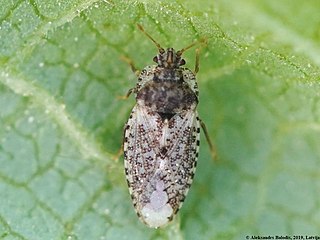
The Pentatomoidea are a superfamily of insects in the Heteroptera suborder of the Hemiptera order. As Hemiptera, they share a common arrangement of sucking mouthparts. The roughly 7000 species under Pentatomoidea are divided into 21 families. Among these are the shield bugs, giant shield bugs, burrower bugs, and stink bugs.

Conium is a genus of flowering plants in the family Apiaceae. As of December 2020, Plants of the World Online accepts six species.

Coreidae is a large family of predominantly sap-suckling insects in the Hemipteran suborder Heteroptera. The name "Coreidae" derives from the genus Coreus, which derives from the Ancient Greek κόρις (kóris) meaning bedbug.

The Pentatomomorpha comprise an infraorder of insects in the true bug order Hemiptera. It unites such animals as the stink bugs (Pentatomidae), flat bugs (Aradidae), seed bugs, etc. They are closely related to the Cimicomorpha.

The Lygaeoidea are a sizeable superfamily of true bugs, containing seed bugs and allies, in the order Hemiptera. There are about 16 families and more than 4,600 described species in Lygaeoidea, found worldwide. Most feed on seeds or sap, but a few are predators.

The Rhyparochromidae are a large family of true bugs, many of which are commonly referred to as seed bugs. The family includes two subfamilies, more than 420 genera, and over 2,100 described species.

Piesmatidae is a small family of true bugs, commonly called ash-grey leaf bugs. The Piesmatidae are distributed mostly in the temperate Northern Hemisphere, with some occurring in Africa, Australia and South America. A common species found throughout the Americas is Piesma cinereum.
The Thyreocoridae are a family of shield bugs, known by common names that include negro bugs or ebony bugs. Historically, a few authors have called this family "Corimelaenidae" (e.g.), but the name Thyreocoridae, published in 1843, has nomenclatural priority over Corimelaenidae, published in 1872. Other classifications have placed them as a subfamily within the broad family Cydnidae.

The Blissidae are a family in the Hemiptera, comprising nearly 50 genera and 400 species. The group has often been treated as a subfamily of the Lygaeidae but was resurrected as a full family by Thomas Henry (1997).

Piesma maculatum is a true bug species found from North Africa to southern parts of Scandinavia and the South of the British Isles then across the Palearctic to the Black Sea region to Central Asia, China and Japan. In Central Europe it is widespread and generally the most common species of the family Piesmatidae.

Drymus brunneus is a species of dirt-colored seed bug in the family Rhyparochromidae found in the Palearctic. In the West Palearctic it is lacking only in the far north of Northern and Eastern Europe. In the East, the species ranges to the Caucasus and Siberia.

Taphropeltus contractus is a species in the family Lygaeidae. It is found in the West Palearctic - in Europe, excepting the far North. In the South of Europe the distribution includes the Mediterranean Basin including North Africa. The East limit is the Caucasus. In Central Europe the species is widespread and it is not uncommon in the South. North of the central uplands, it occurs but only locally. The species occurs only in warmer in the Alps. It prefers half shady, dry warm habitats.
Leptoypha is a genus of lace bugs in the family Tingidae. There are about 17 described species in Leptoypha.
Galgupha is a genus of ebony bugs in the family Thyreocoridae. There are more than 30 described species in Galgupha.

Geocoridae is a family of big-eyed bugs in the order Hemiptera. There are more than 290 described species in Geocoridae.
Isthmocoris is a genus of big-eyed bugs in the family Geocoridae. There are at least four described species in Isthmocoris.

Metacanthus is a genus of stilt bugs in the family Berytidae. There are more than 20 described species in Metacanthus.

Beosus is a genus of dirt-colored seed bugs in the family Rhyparochromidae. There are at least four described species in Beosus.

Henestaris is a genus of mostly European bugs, it is typical of the subfamily Henestarinae.

Enoplops is a genus of Palaearctic bugs, in the family Coreidae and tribe Coreini. Species are recorded from Europe and includes E. scapha found in the British Isles; there are also records from North Africa and China.

















